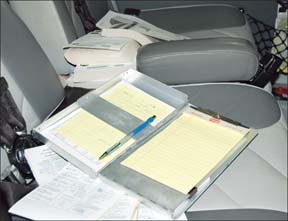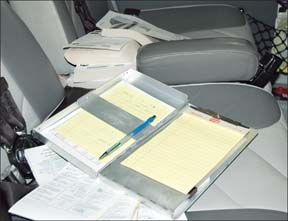
By Frank Bowlin
This is a true story that still scares me after six years: Id hitched a ride from a friend well call Henry. He was a nice guy, very intelligent, but I hadnt flown with him before.
It was VFR under clear, early evening skies. The first trouble sign was copying the Class B departure instructions. Henry had no pen; I offered mine.A 5-year-old Sectional served as notepaper. The next indication was a need to hold the portable intercom just right to hear the radio. After fiddling with the home-made loose connections while getting configured after takeoff and talking to the busy controller, we got the intercom mostly working. Since I was the passenger and it was VFR, I nervously played along.
En route, Henry would climb and descend 1500 feet with no apparent plan or care. Whether VFR or not, it was disconcerting. The plan was to drop me off at my home airport and for him to continue to his airport. By the time we got there, my airport was light IFR with good conditions for the approach. Henry called ATC for a clearance. I supplied the pen again and he found another chart on which to write.
After struggling to copy the clearance and paying some attention to altitude and heading, the next challenge was the approach chart. Henry proudly announced he had approach charts that were only six months old. They were loose-leaf FAA charts, but Henry hadnt bothered with a binder. He actually dug a wad of pages out of a brief case and spread them out on the back seat, and proceeded to shuffle through them, looking for the right one.By this time my self-preservation kicked in and I suggested he just fly to his home airport (still VFR) and Id get home from there.
We can learn a lot from Henrys disheveled, disorganized ways.
Organization – A Way of Life
At one end of the spectrum is Henry, a thinker spending his entire life in chaos. At the other end is the obsessive-compulsive organizer who can be shattered by a last-minute change. Sanity and safety for a pilot-and for passengers-live somewhere between these extremes.
Its one thing to have a favorite headset, seat position, kneeboard and type of pen or pencil. Its quite another to become overly distracted if your pen runs out of ink or turbulece knocks something to the floor. In either event, you still have to fly the airplane. And what will you do if the airplane is a strange one, like when you go flying with someone more organized than Henry, but who still needs a little help now and then?
While cockpit organization definitely involves personal preferences, several things come to mind in the way of guidelines. The “Whats in YOUR Flight Bag?” sidebar provides some basic ideas-and you may have your own. But the keys involve being able to find what you need when you need it. And not taking with you stuff you dont need, which just adds weight, clutter and complexity without really making your flying more efficient, more enjoyable or safer.
Plan the Flight, Fly the Plan
Back to Henry for a moment. He was set for failure before we even got to the plane, without current charts, notepad, pen, working intercom or any plan for the flight. You dont need a painstaking flight plan, but even if youre just going to play on a sunny afternoon, you should have some plan: your destination, route, time and fuel required, actual and forecast weather.
One way to force this planning is to file a flight plan. Yes, radar flight following is more common, but consider filing a good ol fashioned VFR flight plan as a redundancy, and as motivation to create a plan in the first place.You might also consider something like leaving a copy of the flight plan on the front seat of your car as a reminder to close it when you return.
Of course, longer flights require more planning. Regardless of the detail level, you should develop a methodology. Start with weather for all your flights. This could be as simple as a call to a briefer on your way to the airport for some touch-and-goes, or it could start at home with a lengthy Duat session at your computer. Then plan the routes and legs. Use the weather to modify the legs for possible fuel stops or alternates. And then evaluate the likelihood of completing the flight as planned and what youll do if weather or a mechanical problem intervene.
Were not saying you need to print out the Duat session and take it with you, but we are simply advocating that you follow some defined methodology.This will help organize your thinking, ultimately organizing your flight.
For example, when was the last time you did a weight and balance calculation? Youd be amazed at how many flights are blasting around out of limits. Or, maybe you wouldnt.
Finally, fly the plan. Deviations are normal, but track your progress for delays or routing changes lengthy enough to cause fuel concerns. You dont want to suddenly realize youre an hour from home, and an hour behind schedule, with only an hour of reserve fuel.
Habits are Key
On the other extreme from Henry is the friend who took a checkride at night.When he took out his D-cell flashlight from his flight bag, the examiner took it away, saying the batteries were dead. No problem, said our intrepid friend as he took out spare batteries. The examiner was impressed, but took them away and declared the light was broken. It continued with our friend producing even more extra batteries, bulbs, spare flashlights, etc., until the examiner flatly stated that all the flashlights, batteries and bulbs were unusable. No problem, said our friend as he took out one of those chemical light sticks.
Just as its important to have a planning methodology, its important to be habitual about your organization for the flight. Dont just throw your stuff into the plane and blast off. Take time to arrange the essentials.
Find a place for each item and always put it in the same spot. Use your checklist and put it, say, on top of the glareshield. Have your lapboard, notepad, active chart and flight plan on your lap. Put charts to be used later in the map pocket on the sidewall-thats why its called a map pocket.Re-fold all your charts so the route is visible. Find the approach charts youll use and have them handy. Put stuff out of the way if you dont need it. Headset bags, for instance, can be stowed with the baggage-or in the back seat with the mother-in-law.
Beware of yoke gadgets or any device with wires-dress the wires carefully out of the way, ensuring full motion of the controls. Ensure, also, that all the portable, powered stuff is working during your pre-taxi or pre-takeoff checklists. Fumbling around with your moving-map PDA while trying to fly a departure procedure is just asking for a controllers harsh words.
These are just suggestions, but if you find a place for each item and are rigorous about keeping things where they should be, youll be able to put your hand on anything you need without looking for it.
Disciplined Performance
Were always amused by pilots who take notes on their lined notepads in a free form, anything-goes-anywhere fashion. By the time one pilot with whom were familiar had to check in with approach control, he couldnt find the ATIS designator hed just copied.
Instead, write in neat lines chronologically from top to bottom. First is the departure weather. Next is the clearance, followed by any routing changes and the arrival ATIS. If youre in the habit of jotting down frequency changes, consider a column on the right side of the page for those.
Keep it all neat, always put things in the same relative place, and youll always know where to look. If youre disciplined about it, this organized process can help you notice anything missing. All these procedures, habits and methodology are just mental discipline.
One area where Henry needed a lot of work was disciplined performance. You may be VFR with no requirement to precisely hold altitude, but the mark of a professional, disciplined approach to flying is precision, even-or perhaps especially-when it doesnt matter.
Try to hold altitude and heading to tighter tolerances for longer periods of time. Then take a break. Youll likely notice better precision even during the break than you ever saw before. Keep an eye outside for traffic. Bonus: youre improving your scan. Overall, safety is enhanced.
Put It All Together
Start with a methodology for flight planning. Gather just the items youll need for the flight. Look for ways to improve your organization, increase your efficiency. Work hard to always put things in the same places, to always do things the same way (unless you find a better way, then always do it that better way). Ask your passengers to hold things or do things (fold the charts or keep your flight log). Finally, discipline your performance and dont accept anything less than your best. Consider flying with a CFI or someone more experienced than you to pick up some reality-based suggestions on your technique.
With a program like this, even Henry would find himself an organized, disciplined pilot with safety skills of which he could be proud.
Also With This Article
“Good Habits Are Good”
“Whats in YOUR Flight Bag?”
“Are Portable Devices Safe?”
-After 30 years in the computer industry, Frank Bowlin recently joined the ranks of professional pilots. He now serves as a pilot for a large regional airline and as an independent flight instructor.




